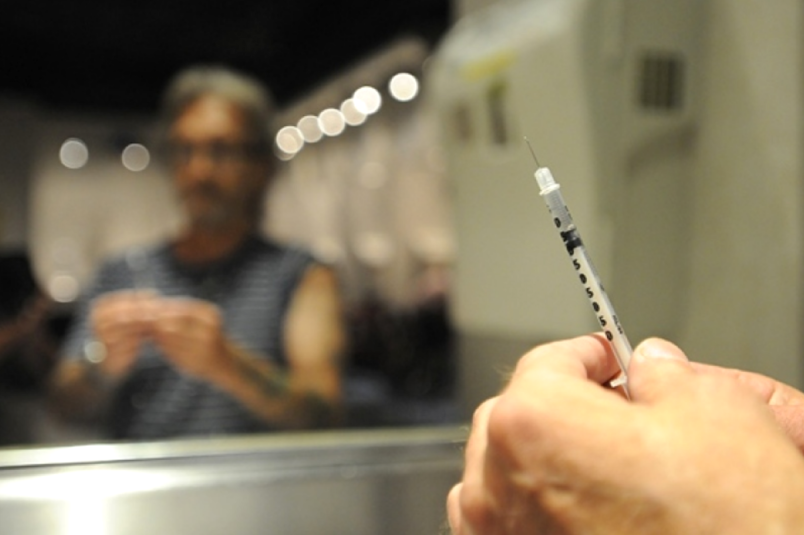Â鶹´«Ã½Ó³»could have its first permanent overdose prevention site outside the Downtown Eastside as soon as November if city council approves a new lease arrangement next week.
The proposed site at the intersection of Seymour and Helmcken streets would add needed overdose prevention and response services in the heart of Vancouver’s Yaletown neighbourhood. The building, two blocks from the busy Granville strip, is flanked by upscale rentals and condos.
Recent anti-homeless and anti-drug user posts from some people in the neighbourhood have raised concerns that the site and its clients could be targets for abuse.
But an advocate who worked on the report to council on the proposal said the increased visibility of homelessness and drug use during the pandemic is exactly why a safe and supportive space is needed.
“That’s the whole point of opening them, is to use more safely indoors,” said Karen Ward, a Downtown Eastside resident and advocate who worked on the report. “You don’t want to be using an alleyway behind a garbage can.
“Sadly, I think that that has been communicated by all of these people all over the city dying.”
Overdose prevention sites are places where people who use drugs can go to test their drugs, get sterile equipment such as new needles and be supervised in the event they overdose.
The sites are an important part of harm reduction for drug users as overdose deaths surge in B.C., partly due to pandemic-driven isolation and increasing drug toxicity. In Â鶹´«Ã½Ó³»alone, 259 people have died of illicit drug overdoses so far in 2020.
Ward said advocates have been asking for a site in the neighbourhood for years, but the need became even more urgent as current overdose prevention sites struggled to serve clients while also complying with COVID-19 precautions. There are currently five permanent sites in the city, all in the Downtown Eastside.

The proposal would move the Thomus Donaghy Overdose Prevention Site, a site near St. Paul’s Hospital’s Thurlow Street entrance, into the first floor of the city-owned building at 1107 Seymour St.
The current tenants would move to new space in the bottom three floors of the building. The other 11 floors of the building include 81 units of non-market rental housing.
“The decline in overdose deaths prior to COVID-19 was seen in part due to the increase of overdose response and prevention services,” reads the report to council.
A new site in Yaletown would provide services to people who use drugs where they work and live, Ward said, and acknowledge they are part of the community.
The report says the neighbourhood’s unique demographic will benefit from another gateway to tailored services, including a safer supply of alternatives to street drugs.
It will also offer staff and users more safety and security at the site, named after peer worker Thomus Donaghy, who was killed in an altercation during a shift at the site in July.
“This new location will allow the Thomus Donaghy OPS to continue to offer life-saving services to the residents of the West End and Granville corridor while increasing physical accessibility and overall safety for service recipients and program staff,” wrote Jennifer Cudlipp, board chair of site operator RainCity Housing, in a Sept. 17 letter to the city.
RainCity did not make anyone available for comment, and neither did collaborator Â鶹´«Ã½Ó³»Coastal Health.
But Charles Gauthier, executive director of the Downtown Business Improvement Association, said the site would be a welcome addition to the neighbourhood as far as his members are concerned.
“We must do whatever we can to provide important resources with as few barriers as possible in the ongoing struggle against the current opioid crisis,” he said in a statement to The Tyee. “The association believes that harm reduction strategies, including well-placed supervised consumption sites and a safe drug supply, can contribute to healthier, safer communities.”
Both Ward and Mary Clare Zak, the city’s managing director of social policy and planning, expect the proposal to be approved by council, but anticipate criticism from nearby businesses and housed residents.
They hope any opposition is focused on increasing supports and housing people, rather than blaming or shaming them.
“We expect it will create some negative backlash,” said Zak, lead author of the report.
Ward said people who are worried about how the site could change the neighbourhood should demand more action from governments on homelessness and the overdose crisis. “Corpses everywhere” would be much worse than having an imperfect site, she said.
“This is part of the world that we have created. Instead of being angry, it’s visible, let’s address it in a real way,” she said.
Moira Wyton is a reporter with The Tyee, where this story first appeared.







